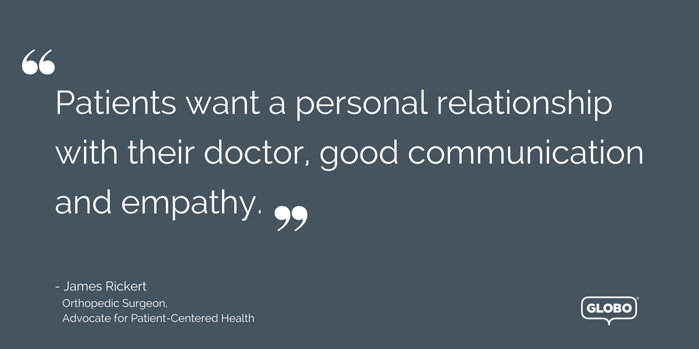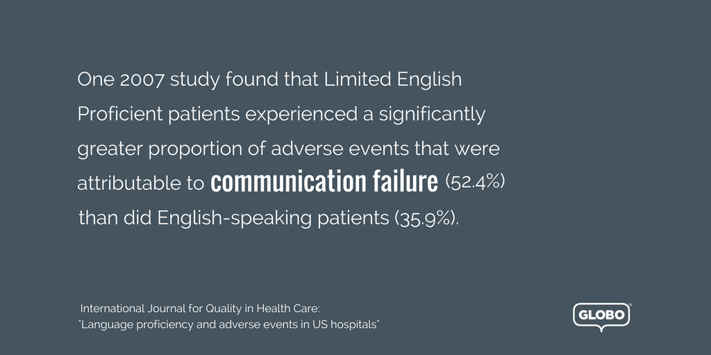Stay up to date.
Stay connected with tips, resources & stories on language access.
At 18 percent of the U.S. gross domestic product, the healthcare industry is a mammoth web that ties together for-profit and nonprofit health systems, insurance companies, government agencies and consumers. Still, even the slightest shift in thinking--like moving from doctor-centric decision making to patient-centered care--can cause rippling effects throughout the industry.
The Institute of Medicine defines patient-centered care as “respectful of and responsive to individual patient preferences, needs, and values, and ensuring that patient values guide all clinical decisions.” The model ensures that patients have a voice in their care.
Do you notice that slight shift? Instead of a physician making every decision, patients are part of the decision-making process around their health. Advocates argue that patient-centered care improves health outcomes while simultaneously reducing costs.
But there’s a rub--if patients can’t understand their doctor or nurse, they can’t be part of the decision-making process. To bridge communication gaps, healthcare systems must partner with a language services provider.
In this post, I’ll explain how access to language support improves the patient experience and aids in better outcomes--two centerpieces of patient-centered care.
Patient-centered care is more than bedside manner. James Rickert, an orthopedic surgeon and advocate for patient-centered health, summed this idea up perfectly: “Patients want a personal relationship with their doctor, good communication and empathy.”
That’s because health is personal, and better communication between doctors and patients produces higher patient satisfaction. No longer is the edict, “Take two pills and call me in the morning” acceptable. When patients and doctors understand each other (good communication), patients report higher satisfaction, reduced symptoms and ultimately, better health outcomes.
Unfortunately, patient-centered care fails when communication breakdowns occur. A language barrier often limits effective communication between providers and limited-English patients. The population of limited-English speakers in the United States is growing--right now, one in five people are classified as Limited English Proficient--and 90 percent of that population is above the age of 18. These individuals make their own healthcare decisions, but poor communication greatly influences the care they receive.
That’s why language services and better language access are so critical in medical offices, hospitals and other healthcare clinics. Qualified medical interpreters foster better communication between doctors and patients, and therefore improve patient happiness and enhance the quality of care. Empathetic doctors and nurses that are knowledgeable about the beliefs and values that different cultures hold, known as cultural competence, play an important role in patient-centered care, too.
In addition to improving patient satisfaction, increased access to qualified medical interpreters improves medical comprehension and cuts the risk of miscommunication. That’s critically important because limited-English patients are more likely to miss appointments--or in the worst case scenario, be harmed-- because of breakdowns in medical communication.
One 2007 study, which examined more than one thousand adverse incident reports from six U.S. hospitals, revealed that, “Language barriers appear to increase the risks to patient safety.” The study continued: “LEP [Limited English Proficient] patients experienced a statistically significantly greater proportion of adverse events that were attributable to communication failure (52.4%) than did English speaking patients (35.9%).” Other research has found that lack of language access decreases overall access to important healthcare procedures.

Healthcare systems must partner with a language services provider that employs qualified medical interpreters to aid in clear and accurate patient-provider communication. Better communication boosts a patient’s confidence in their medical diagnosis and treatment. Not only does access to medical interpreters raise the level of patient satisfaction but it also improves quality of healthcare. Qualified linguists with medical interpreting certifications are less likely to make serious errors than interpreters with less experience. Medically qualified interpreters should have at least two years of interpreting experience, must be versed in important medical concepts and terminology, and must adhere to accepted interpreter ethics like patient confidentiality.
Patient-centered care is gaining traction at the same time its counterpart, value-based care, is becoming a fundamental cog in the healthcare industry. Two of the nation’s largest health insurers recently announced they’re paying out almost half of their reimbursements through the value-based care model.
Healthcare systems can boost the quality of care they provide by leaning in on the patient-centered care model, and improving language access to their limited-English-speaking patients. Improving language support for these patients not only increases patient satisfaction, but can create more favorable health outcomes. Patients at the center of the decision-making process are happier with their care, and with the combination of improved language access and value-based care principles, receive better medical treatment.
Language Support Made EasyGLOBO’s powerful language services platform, GLOBO HQ™, combines technology, data and qualified linguists to provide you with the language services your health system needs. Schedule a demo to learn how you can improve language access with unified language services as your system moves toward patient-centered care. |